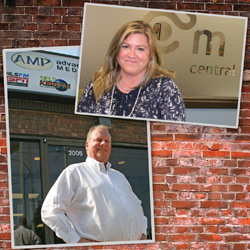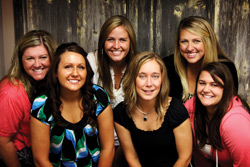
Resident media experts Ann Johnston and Michael Rea serve a wide range of media needs while gathering hints about its ambiguous future.
Upon entering the Media Plaza on Altorfer Drive in north Peoria, one is immersed in a whirlwind of creative activity. From radio personalities broadcasting from its studios to designers concocting eye-catching websites, all manner of media are welcome here. The building’s diverse mix is the creative output of Central States Media (CSM) and Advanced Media Partners (AMP). And though they share an office building, Ann Johnston, CSM president, and Michael Rea, president of AMP, explain that they are distinct and separate businesses.
With its four local stations, AMP is sharply focused on the radio industry, while CSM is a full-service marketing firm, working with clients in print, outdoor, television, radio and online media. But Johnston and Rea share more than an office building. This married couple possesses a similar love for the media, having first met while employed at the same radio station, and often working side by side in the years following. And now, after traversing the ever-winding media road, Johnston and Rea harness their collective expertise to share with fellow Peorians.
Catching the Waves of AMP
With years of radio experience to his name, Rea is no stranger to the ups and downs of this particular form of media. After earning a degree in business, he began working in sales at WIRL-AM, and took to the job immediately.
“I think what really got me was that it’s different every day. You are dealing with different clients, and there’s different things going on at the station,” he recalls. “There’s always something going on that you don’t really expect.”
After transitioning to WWCT in the mid ‘80s, Rea was promoted to sales manager and then station manager. While there, he met Johnston, who was also in sales. In 1996, the couple purchased their first radio station together, WJPL Smooth Jazz 96.5, and secured a construction permit to build it from the ground up. Not long after, Rea and Johnston bought a second station and transformed it into WZPW Power 92.
But in the wake of the historic Telecommunications Act of 1996, consolidation swept through the radio world. Despite its stated intention to increase competition in the industry, the law actually led to a steep decline in the number of station owners, even as the number of stations across the country was on the rise.
In this environment, Rea had to choose between expanding his stations or selling them. A broker from Providence, Rhode Island, put him in touch with AAA Entertainment, a company out east. Rea joined with AAA and became a minority partner, which expanded the company’s radio holdings from Peoria to Bloomington, Champaign, Long Island, Providence and Connecticut. In an unfavorable agreement with the equity partners, Rea and AAA decided to sell the stations in 2006.
After completing the sale, Rea joined his wife on the Central States Media team, but he wouldn’t be kept out of radio for long. Last November, Rea closed the deal on his purchase of the four stations that fall under the AMP banner: 96.5 ESPN, 98.5 KISS FM, 99.9 WWCT and 101.1 JACK FM.
Having previously worked under non-local ownership, Rea takes great pride in running one of the last remaining locally-owned media outlets. “We don’t have to get permission from someone in L.A.,” he notes. “If we want to do something, we can make our own decisions.” He also mentions the advantages that locally-owned radio offers fellow Peorians.
“Everything that we do in the market stays in the market,” says Rea. “Working locally…this is it. When we do well, it stays here, and we are able to hire more people and be really centrally focused on this market.” A Win-Win Situation
A Win-Win Situation
With a vast reservoir of radio knowledge, Rea offers some advice for would-be broadcasters. “You have to be careful that you don’t rely too much on technology,” he warns. “[Radio] is still a one-on-one media…even though the DJ is talking to 10,000 people…he has to relate one on one to the audience.” Rea reveals how to achieve this in local radio.
“Good local stations provide something of value to the listeners. Whether it’s information about what’s going on locally or music that you can’t get anywhere else…You have to have a way to relate to the audience.” Rea’s latest strategy to strengthen his stations’ connection to listeners involves decreasing commercial time.
While advertisements consume, on average, 12 to 15 minutes of each hour on most commercial radio stations, Rea is cutting that number closer to eight. “That is going to make our commercials work better for our advertisers because [the audience] is not fighting through so much clutter,” he says. “It will also be nice for listeners because they aren’t hearing two songs and then eight commercials.”
Such a decision illustrates Rea’s point about the benefits of local ownership. Unencumbered by the demands of a bank, bureaucracy, equity partner or shareholder, he has more freedom to cater to his audience. “We are certainly conscious of the bottom line, but we feel like the best way to achieve that is to do a really nice job for our clients and the listeners,” he attests. Johnston agrees, summing up the couple’s shared objectives in a few simple words: “We want to do it right.”  Designs for Success
Designs for Success
And for Johnston, “doing it right” can mean any number of things, as her full-service marketing company handles everything from designing logos and websites to buying TV and radio ads for clients. With such a broad range of duties to oversee, Johnston states the driving philosophy of Central States Media.
“I love the ability for all of the media to work together,” she says. “I believe a good, effective campaign is not just one thing—it’s a combination.” She adds that for some clients, CSM handles the entire media campaign from production to placement, while for others, the company takes on a specific assignment.
In any case, before their work can begin, Johnston spends time with each client to determine their needs and goals. Having counted the likes of the New York Giants football team among her clientele, she offers solid experience helping organizations hone their future ambitions. “It’s important to figure out what they want to do and how they want to get there,” she states. “Everything we do is from a goal perspective.”
Johnston explains that this process narrows the playing field to target media outlets best suited for the individual client. Every business is different, and so this targeted approach is crucial. “For some people, the Internet is a lead revenue source,” she adds, “but there are others that thrive with external media, print or outdoor.”
Johnston’s toolbox of media knowledge stems from her dedication to keeping up on the latest technologies and industry practices. “You have to read, you have to be on webinars, you have to learn,” she says. “I have to invest in myself, and our staff does the same thing.”
Standing Out, Not Alone
But staying competitive is about more than just keeping up with change. Johnston expresses that the next step involves finding a way to really connect to the client’s audience—and prospective audience. “It’s great to have a beautiful website and Facebook, but how do people then create communication with that potential person?” she muses. Search Engine Optimization (SEO) is one way CSM makes its clients’ websites stand out amidst the limitless clutter of the Internet.
SEO involves the structuring of websites so they appear near the top of search results pages for relevant keywords. It’s a complex process, with dozens of factors involved in the rankings, but thankfully, clients need not worry about its intricacies. “When we build a website,” Johnston assures, “it’s going to have all the backend functionality to help it perform the best it can.”
Sometimes that means tapping the expertise of specialists outside the company. To that end, Central States partners with “best-of-breed” companies who lend a hand with specific technical projects. “It’s more cost-effective,” Johnston says. “We know they have proven results.”
It is that dedication to putting together the best possible solutions for its clients that sets CSM apart. Rea points out that keeping up with the latest media trends can be tedious, yet it is an essential task that requires continual attention. And CSM’s clients are always on the cutting edge. “[They] don’t need to do the research and find out what the next big thing is,” says Rea. “They’ve got [Johnston] taking care of it.”
The Media Forecast
In terms of defining “the next big thing,” Rea and Johnston agree that there is no clear-cut answer. But, asserts Rea, “I’d say one of the questions on the horizon is the proliferation of smartphones…how people will consume media.” With the ability to download TV shows and listen to satellite radio right in your pocket, most media can be accessed at any time, anywhere.
“[Media] is always going to be evolving,” Rea states. “But at some point,” he adds with an air of caution, “technology can outpace what the consumer is willing to take the time to do.” In fact, many people have no interest in watching movies on a three-inch smartphone screen.
Looking out across the media landscape, it’s nearly impossible to see what lies ahead. Johnston recalls past predictions: TV would kill radio, DVRs would kill TV, satellite radio would kill FM, the Internet would kill print. None of those things happened. But, adds Johnston, such threats had an effect on media providers. “It forced people to be better,” she says. “You have to be better.” iBi

